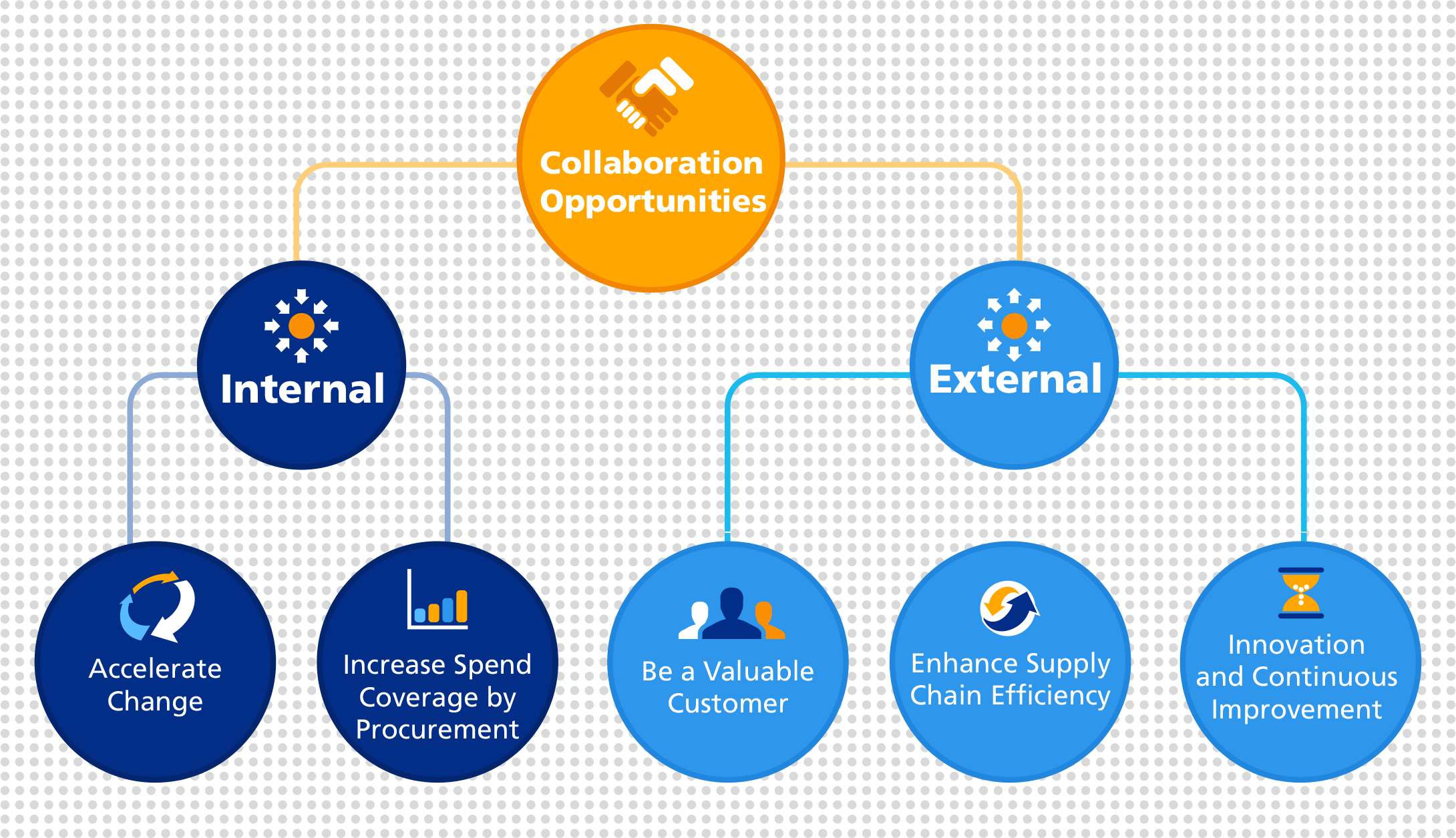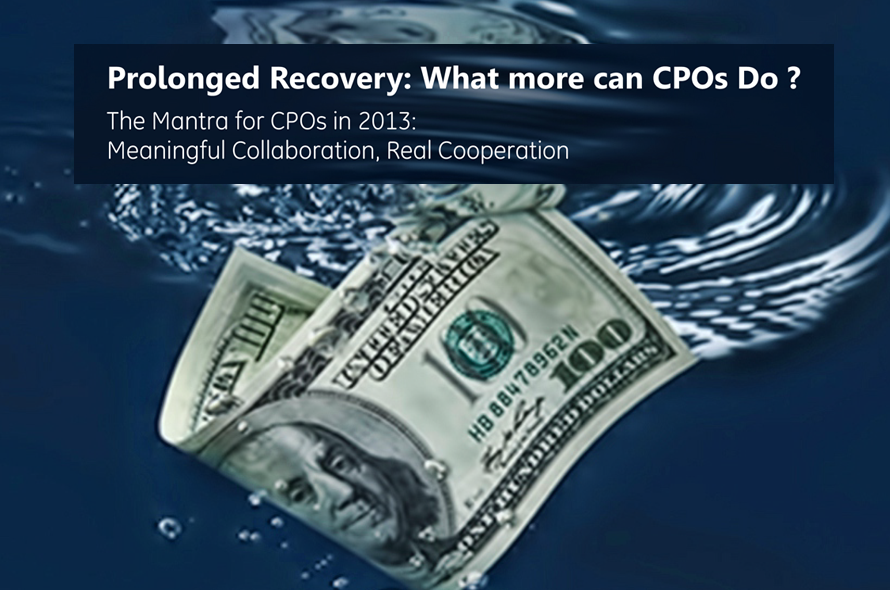Introduction
The IMF's bi-annual World Economic Report for 2013 is just out. And the news isn't too good. There's excessive short-term fiscal tightening in the United States, prolonged stagnation in the Eurozone, pessimism about the economy in Japan, uncertainty in emerging economies – and more. More confirmation of the bad news: Davos 2013 closed with the bleak observation that the economic recovery has been fairly unspectacular and much won't change in the near future. And OECD has slashed its growth forecast for 2013, indicating the risk of a serious global recession cannot be ruled out.
Obviously, companies are a worried lot. They're having to tighten their belts significantly, but the trouble is there aren't too many notches left. Supply chains are in a fragile state and will be under pressure throughout 2013 to sustain top line revenue growth. Cost reduction pressures will most likely increase as firms try to preserve cash and reduce expenses. Procurement teams will be challenged to uncover even more cost-cutting opportunities.
What does this mean for companies? Perhaps this is the time to shift away from short-term measures and dig deeper into the supply chain to look for solutions. This would not only help them weather these troubled times but also enable them to prosper when the good times return. Firms have to sow the seeds of growth now to reap results later.
The Need Now: Internal and External Collaboration
Supply chains are reeling under the stress of uncertain demand outlook, tighter credit and volatile commodity prices. And the recent focus on becoming lean and reducing supply chain buffers has increased the exposure of companies to supply chain disruptions, suppliers going bankrupt and unfavorable geo-political changes. Unidimensional strategies, where suppliers are expected to reduce prices and offer favorable terms, will not work anymore. A change in thinking is needed. A fresh strategy is required. And that strategy is meaningful collaboration, real collaboration.

Moving From “Have to Collaborate” to “Want to Collaborate
Companies need to view collaboration as a costsaving strategy in a very different manner. The entire thought process needs to change. Firms should not see collaboration as a compulsion or a last-resort that will save them the blushes at the last moment, but as a first-off, meaningful exercise that can provide not just measurable savings, but longterm value. As CEOs increasingly look towards procurement to deliver year-on-year cost-reductions, procurement leaders need to collaborate at various levels with both internal and external stakeholders.

Increasing Collaboration with Internal Stakeholders
Collaborating with internal departments can be the single most value-generating activity firms can think of in these troubled and uncertain times. It can increase efficiencies, lead to innovation, reduce time-to-market and result in measurable savings.
Now is the time for procurement leaders to demonstrate how to do more with less. How to make reduced budgets result in expanded savings. Procurement has historically fought tough battles to get more spend under its influence; this is the time for procurement to make its case more strongly and convince the powers that be to change the discourse and revamp the business strategy – make collaboration between other business divisions and procurement the preferred strategy rather than the last option. The tough times demand that business and procurement shrug off their personal agendas and truly collaborate to come up with fresh ideas that can bring more value from suppliers.
Moreover, procurement needs to step up and push for results in areas not fully exploited. And investigate whether policies that were intended to result in savings have actually done so. And if they have, to what extent? All business stakeholders need to come together and identify the exact causes of nonrealization of intended savings. These could be a wrong policy, maverick buyers or an underperforming supplier. This is also the time to go for more bold approaches, as that can change the game altogether.
Accelerate Change
Accepting change is not going to be enough; this is the time to embrace change, to facilitate it and accelerate it. Change management is critical and the key differentiator between a roaring success and near-failure.
The first thing that needs to change is the attitude towards procurement. Often, marketing will think of procurement as a last resort, a desperate measure when everything else has failed. Companies need to find out why procurement is not used earlier, much earlier. Procurement needs to be involved from the beginning and not summoned somewhere towards the end.
Then there are changes that are proposed but never implemented, or put on hold. This could be because the economic environment is not right, or a proposed change is seen as too big or too radical a departure from the norm. Well, it is time to dust off the policies and plans that have ended up on a shelf and implement them.
For example, there are certain categories that involve a long series of qualification tests to be carried out before a supplier is commissioned. Often, the quality and R&D teams are at loggerheads with procurement regarding supplier selection. So they do not initiate the qualification process, delaying the supplier rollout indefinitely. Now is the time when procurement needs to sit down with the business stakeholders, understand their reservations and create an environment conducive for collaborative brainstorming that can result in overall value realization.
Similarly, you could spot other areas where changes can be made, and managed. Implementing wellthought-out changes can reduce maverick spend and non-contractual buying. The need now is to identify shortcomings in the present procurement policies and constantly push for changing them.
Increase Spend Coverage of Procurement
When times are good, many companies don't feel complled to examine all their spend and bring it within the ambit of procurement. But these are not good times – far from it. So, take a good, hard look at your entire spend and get more and more of it under coverage. Examine your indirect spend, and other areas that were previously left untouched.
Most of the time, these areas are not a priority for procurement. Even in companies where procurement is involved in these categories, it is restricted to lowpriority assignments. Moreover, many companies do not see spend on indirect materials and services as core to their business and do not really have a procurement strategy for them. So, they lack visibility into the majority of indirect spend categories that can be addressed to yield 10 per cent to 20 per cent savings on an average.
These are the untapped opportunities for CPOs to realize additional savings. There have been several areas that are traditionally considered off-limits for the procurement team. These include marketing, legal and other general and professional services. Procurement organizations need to develop a thorough understanding of these domains and bring enough value to the table so that business is compelled to consult them before making any major decisions.
Another opportunity procurement leaders can target is the tail-spend. Traditionally, companies have focused on categories accounting for 80 per cent to 90 per cent of spend, while the 'tail', making up the remaining 10 per cent to 20 per cent, has been largely ignored. In most cases, tail-end spending is done through one-off buys, or through contracts that are renewed periodically without much negotiation. In most of these categories, savings can be achieved through simple e-sourcing techniques as price is the main driver.
Increasing Collaboration with External Stakeholders
Suppliers are one of the most important external stakeholders of a company. The shaky economic recovery has put immense pressure on the supply chain, leaving it with very little maneuver room. Companies are not going to realize serious savings by pushing their suppliers for lower and lower prices. If they persist, they may get some savings, but aggressive bargaining can result in cutting into the bone of supply chain performance capabilities.
In fact, persistent demands for price concessions can put suppliers right out of business. So you get a small benefit in the short run, and cause a big loss to your supplier. This is a short-sighted approach and is best shunned. Instead, companies need to collaborate better with their supply chain and adopt a transparent approach towards it.
Take the case of one of the world's largest and most successful companies, Apple Inc. Apple has invested significantly in supplier relations to reach where it stands today. Be it innovation sourcing, supplier development, volume commitments, co-designing and co-development, or supplier financing, the company epitomizes supplier collaboration in letter and spirit. Apple truly partners with its suppliers and enables them to come up with cutting edge technologies that eventually feature in its products.
Recently, CEO Tim Cook declared that the company would invest $100 million to bring part production of its Mac computers back to the US by way of partnerships with local suppliers.1 Not only will such a move give Apple better control of its supply chain, the suppliers stand to gain immensely as well.
Engineers from Apple's procurement operations team continuously scout for new suppliers that can give them the next leap in the market, often reaching out to small, nondescript suppliers in Taiwan and China. It is obvious organizations can no longer have a mere transactional outlook towards their suppliers. Strategic suppliers need to be identified and procurement and business need to engage with them to understand how they can work towards improving their operations/products. Hurdles, if any, have to be pinpointed and both parties have to work together to overcome them.
Enhance Supply Chain Efficiency
A robust supply chain is a company's biggest asset. But presently, most supply chains are on a sticky wicket. In such a situation, demanding more and more from it will be disastrous. The current economic scenario particularly calls for a collaborative approach and sensitive handling. This is the time for enhancing the efficiency of your supply chain. In fact, investing in the supply chain for long-term gain is a very wellaccepted business practice.
While it may not be possible for many companies to emulate the example of Apple, it is entirely possible to establish and maintain an effective supply chain for the business in meaningful ways. Companies can start by maintaining transparent counterparty relationships. This is also the time to bolster the supply chain with innovative payment solutions and small logistics changes. For example, your logistics providers may be able to provide you a discount owing to reduced fixed overheads if your warehouse operates an extra shift, enabling you to transport one more truckload per day. Such small measures may seem insignificant, but in their totality, could amount to considerable savings.
Innovation and Continuous Improvement
Most companies focus too much on listening to their customers, but ignore their suppliers. Your suppliers are your allies. They supply to many of your competitors as well. They know the business better than you do. Understand them, engage with them, listen to them. They might have ideas that are mutually beneficial.
Besides, exploring innovative approaches to business is what will help. In fact, firms should incentivize new ideas offered by channel partners. It is time to turn to them for suggestions. Unilever, for instance, launched a special program called “Open Innovation” in early 2012. The program aimed at bringing together suppliers from across the value chain to find answers to some of the toughest challenges that bog down the global food major. Following its success, Unilever is replicating it on a much larger scale.
Be a Valuable Customer
Companies spend a lot of time evaluating the performance of their suppliers, but seldom measure themselves. Is your company a good customer to its suppliers? If you are a valuable customer, your suppliers will go the extra mile for you, bend over backwards for you. If you are not, you may not be extended even simple favors.
Being a valuable customer means many things. It means keeping your end of the commitment, but it also means extending a helping hand to your suppliers, as and when needed. It could mean capacity commitment, innovative payment terms, taking occasional late payments in your stride, etc. If you indulge your suppliers occasionally, chances are they will provide you meaningful discounts regularly.
Here is an example of being a good customer to suppliers — in late 2008, numerous small auto parts suppliers in Detroit area filed for Chapter 11. But several of them were eventually saved from complete obliteration, thanks primarily to companies such as Toyota and Nissan, which, recognizing years of successful partnership, continued their patronage of the suppliers.
There have been instances where GEP has helped its clients carry out sub-tier sourcing, enabling its clients' packaging suppliers get access to better paper/plastic prices. GEP has also clubbed the demand of a small logistics player with a bigger pool so as to get the smaller player better rates.
The savings companies realize by taking small steps may become substantial in the long term. The trick lies in collaborating, innovating and thinking ahead.
Conclusion
Clearly, the on-going economic environment remains anemic — robust recovery has yet to develop. Procurement has some hard work to do. But it is not an impossible task. There are unexploited areas where procurement can add considerable value. It will not be easy to spot those areas, and many of them might provide only limited savings. But it all adds up. So, start looking for the untapped opportunities, think out-of-the-box and engage in real collaboration for the next level of savings, real results and long-term value.

